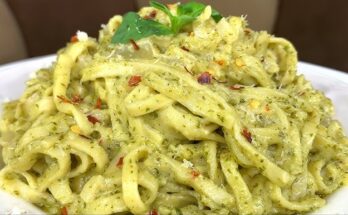Chicken Cabbage Recipe: If you’re looking for a wholesome, tasty, and easy-to-cook recipe, chicken cabbage is a perfect choice. It’s a dish that combines the lean protein of chicken with the crunch and nutrition of cabbage, giving you a balanced meal that works for both lunch and dinner. The best part? You don’t need to be a pro chef to whip it up. With simple ingredients and a straightforward cooking process, this recipe can easily become a staple in your weekly meal plan.
Introduction to Chicken Cabbage Recipe
Chicken cabbage is a comforting and versatile dish that can be enjoyed in different ways. Whether you’re aiming for a light stir-fry, a hearty curry, or even a soup-style version, the combination of tender chicken and fresh cabbage never disappoints.
One of the biggest advantages of this recipe is its nutritional value. Chicken is a rich source of protein, essential for muscle repair and energy, while cabbage brings fiber, vitamins C and K, and antioxidants to the table. Together, they form a powerhouse meal that supports both taste and health.
Another reason this recipe is so popular is its adaptability. You can keep it simple with just a few seasonings or elevate it with garlic, ginger, soy sauce, or even creamy sauces, depending on your mood and pantry. Plus, it’s budget-friendly since both chicken and cabbage are affordable ingredients that go a long way.
If you’re someone who’s always short on time, you’ll love how quickly this dish comes together. With a bit of chopping, marinating, and sautéing, you’ll have a nutritious meal ready in under 40 minutes.
Ingredients You’ll Need
Main Ingredients
- Chicken – Boneless chicken breast or thighs work best, cut into bite-sized pieces.
- Cabbage – Green or white cabbage, finely shredded.
Optional Additions for Extra Flavor
- Carrots (sliced thin for extra crunch)
- Bell peppers (for color and sweetness)
- Onions (to deepen the flavor)
- Mushrooms (for a meaty texture)
Spices and Seasonings
- Salt and black pepper (basic seasoning)
- Garlic (minced for aroma and flavor)
- Ginger (adds a warm, zesty kick)
- Soy sauce or oyster sauce (for Asian-style taste)
- Chili flakes or fresh chili (if you like it spicy)
- Olive oil or sesame oil (for cooking and added richness)
These ingredients can be adjusted depending on your taste. The beauty of this recipe is that it’s flexible—feel free to experiment with different herbs and spices.
Kitchen Tools and Preparation
Essential Tools
- A sharp knife and cutting board
- A large skillet, wok, or frying pan
- Mixing bowls for marinating chicken
- A spatula or wooden spoon
Prepping the Chicken
Wash and pat dry the chicken before cutting it into bite-sized pieces. If you’re using chicken breast, try to cut them evenly so they cook uniformly. For juicier results, chicken thighs are also a great option.
Prepping the Cabbage and Vegetables
Shred the cabbage into thin strips so it cooks quickly without becoming soggy. If adding other vegetables, slice them thinly as well for an even stir-fry effect.
Step-by-Step Guide to Making Chicken Cabbage
Step 1 – Marinate the Chicken
In a bowl, combine chicken pieces with a pinch of salt, pepper, minced garlic, and a splash of soy sauce. Let it sit for at least 15 minutes. This simple step enhances the flavor and ensures that the chicken stays tender during cooking.
Step 2 – Cook the Chicken
Once the chicken has marinated, heat a large skillet or wok over medium-high heat. Add a little olive oil or sesame oil for a rich flavor. Place the chicken pieces in the pan and spread them out evenly so they cook properly. Avoid overcrowding the pan—if you have a lot of chicken, cook it in batches.
Cook the chicken for 5–7 minutes, stirring occasionally until it turns golden brown on the outside and is fully cooked inside. You’ll know it’s ready when the juices run clear and there’s no pink in the middle. Be careful not to overcook, as chicken breast especially can become dry and tough.
For extra flavor, you can splash in a little more soy sauce, oyster sauce, or even chicken broth while cooking. This not only keeps the chicken moist but also creates a tasty base for the cabbage and vegetables you’ll add later. Once cooked, set the chicken aside on a plate.
Step 3 – Sauté the Vegetables
In the same pan (don’t wash it—you want all those delicious flavors left behind from the chicken), add a bit more oil if needed. Toss in minced garlic, ginger, and onions, sautéing them until fragrant. This is the foundation of your flavor and will make the dish smell amazing.
Next, add in carrots, bell peppers, or any other vegetables you’ve chosen. Stir-fry them for about 3–4 minutes, just enough to soften slightly but still keep their crunch. Now it’s time for the star ingredient—shredded cabbage. Add it to the pan and give everything a good stir.
Cabbage cooks quickly, so keep the heat medium-high and stir often to avoid sogginess. You want it tender yet still crisp. At this stage, season with a little salt, pepper, and maybe a pinch of chili flakes for heat.
Step 4 – Combine Chicken and Cabbage
Once the vegetables are halfway cooked, add the chicken back into the pan. Mix everything together, letting the flavors blend. If you like a saucier dish, pour in a small amount of chicken broth or water along with soy sauce and let it simmer for 2–3 minutes.
Stir continuously so that the chicken and cabbage absorb all the seasoning. You’ll notice the cabbage slightly wilting but still holding some crunch—that’s exactly what you want.
If you’re going for a more Asian-style stir-fry, a drizzle of sesame oil and a sprinkle of sesame seeds at this stage works wonders. For a creamier twist, you could even add a splash of coconut milk or a spoon of cream, though that’s completely optional.
Step 5 – Final Touches and Garnishing
To finish, taste the dish and adjust the seasoning if needed. Maybe a dash more salt, a grind of fresh black pepper, or even a squeeze of lemon juice to brighten the flavors.
Garnish with fresh herbs like cilantro, parsley, or green onions for a burst of freshness. If you like spice, top with sliced fresh chili or a sprinkle of chili flakes. For added crunch, toasted sesame seeds or crushed peanuts make a fantastic finishing touch.
Your chicken cabbage is now ready to serve—hot, flavorful, and perfectly balanced between protein and veggies.
Tips for the Perfect Chicken Cabbage Dish
How to Keep the Chicken Juicy
The secret to juicy chicken lies in two things: marination and cooking time. A simple marinade with garlic, soy sauce, and a bit of oil works wonders. Avoid overcooking by keeping an eye on the chicken—once it turns white inside and golden outside, remove it from the pan.
How to Avoid Soggy Cabbage
Cabbage releases water when overcooked, which can make the dish watery. The trick is to cook it on high heat for a short time. Stir-fry quickly to keep it crisp. If you notice excess water, turn up the heat to evaporate the liquid.
Best Substitutes for Ingredients
- Instead of chicken breast, use chicken thighs for a richer taste.
- For a vegetarian option, replace chicken with tofu or mushrooms.
- Instead of soy sauce, try tamari for a gluten-free option or oyster sauce for deeper umami flavor.
- Don’t have sesame oil? Use olive oil or peanut oil instead.
Serving Suggestions
With Rice
Chicken cabbage pairs wonderfully with steamed white rice, fried rice, or even brown rice if you want a healthier option. The rice soaks up all the flavors, making every bite satisfying.
With Bread or Roti
In many households, chicken cabbage is served with flatbreads like roti, naan, or parathas. The combination is simple yet filling, and it’s a great way to enjoy the dish if you’re not in the mood for rice.
As a Low-Carb Meal
If you’re watching your carbs, you can skip the rice and bread and enjoy chicken cabbage on its own. It’s filling enough with just the protein and fiber-rich veggies. Alternatively, serve it with cauliflower rice or zucchini noodles for a healthier spin.
Variations of Chicken Cabbage Recipe
One of the best things about chicken cabbage is how versatile it can be. With just a few tweaks in spices, sauces, and cooking style, you can transform this simple recipe into completely new versions that suit different palates and occasions.
Spicy Chicken Cabbage
If you love a kick of heat in your meals, spicy chicken cabbage is the way to go. Simply add extra chili flakes, chopped green chilies, or even hot sauces like sriracha while cooking. You can also stir in some crushed red pepper for a smoky spice. This variation pairs perfectly with plain rice or noodles because the spice brings everything alive.
For an even bolder version, try adding a spoonful of chili paste or sambal oelek. It turns the dish into a fiery, flavor-packed meal that spice lovers will adore.
Creamy Chicken Cabbage
For those who prefer a rich and comforting dish, creamy chicken cabbage is an excellent twist. After cooking the chicken and veggies, add a splash of heavy cream, coconut milk, or even a cream-based sauce. This creates a velvety texture and a mild flavor that balances the crunch of the cabbage.
You can also sprinkle grated cheese on top for a cheesy, indulgent version. Pair this with warm bread or pasta for a cozy dinner option.
Stir-Fried Chicken Cabbage (Asian Style)
For a quick, light, and flavorful meal, go for an Asian-style stir-fried chicken cabbage. Use sesame oil, soy sauce, and a dash of oyster sauce as your main seasonings. Toss in sliced carrots, mushrooms, and bell peppers for added variety. Finish with sesame seeds and spring onions for authentic flavor.
This version works beautifully with fried rice, noodles, or even on its own as a quick lunch or dinner.
Nutritional Benefits of Chicken Cabbage
Apart from being delicious, chicken cabbage is also packed with nutrients, making it a wholesome dish that supports a healthy lifestyle.
Calories and Macronutrients
A serving of chicken cabbage (without heavy sauces) is generally low in calories, making it a great choice for weight management. Chicken provides lean protein, which helps build muscle and keeps you full longer. Cabbage, on the other hand, is low in calories but high in fiber, making the meal both satisfying and light.
Vitamins and Minerals
Cabbage is loaded with vitamins C and K, both of which are essential for immunity and bone health. It also contains antioxidants that fight inflammation. Chicken brings in important nutrients like B vitamins (B6 and B12), iron, and zinc, all of which are vital for energy and overall health.
Health Benefits for Weight Loss and Immunity
If you’re trying to lose weight, chicken cabbage is a smart option because it’s filling without being heavy. The high protein from chicken curbs hunger, while the fiber from cabbage keeps digestion smooth. Plus, the vitamins in cabbage boost your immune system, making this dish not only tasty but also good for your body.
Common Mistakes to Avoid
Even though chicken cabbage is easy to make, there are a few mistakes that can ruin the dish. Here are some to watch out for:
- Overcooking the Chicken: Chicken can quickly become dry and chewy if cooked too long. Keep an eye on it and remove it from heat as soon as it’s done.
- Using Too Much Oil: Cabbage absorbs oil easily, which can make the dish greasy. Stick to a small amount of oil and add liquids like broth if you need moisture.
- Not Seasoning Properly: Cabbage can be bland if under-seasoned. Make sure to balance your flavors with enough salt, pepper, garlic, or soy sauce.
- Overcrowding the Pan: When cooking, especially in a stir-fry, overcrowding leads to steaming instead of frying. Cook in batches if needed.
By avoiding these mistakes, you’ll always end up with a delicious, well-balanced dish.
Make-Ahead and Storage Tips
One of the perks of chicken cabbage is that it stores well, making it perfect for meal prep or busy weeknights.
How to Store in the Fridge
Allow the dish to cool completely before transferring it to an airtight container. Store in the refrigerator for up to 3–4 days. When reheating, warm it gently on the stove to maintain the texture of the cabbage.
How to Freeze for Later
Chicken cabbage can be frozen, but cabbage tends to soften after thawing. If you don’t mind a slightly softer texture, store it in freezer-safe bags or containers for up to 2 months. To reheat, thaw overnight in the fridge and warm on the stove.
How to Reheat Without Losing Flavor
The best way to reheat chicken cabbage is on the stovetop over medium heat. Add a splash of broth or water if it seems dry. Avoid microwaving for too long, as it can make the cabbage mushy.
Why You’ll Love This Recipe
- Quick and Easy: Ready in under 40 minutes, perfect for busy weeknights.
- Healthy and Nutritious: Packed with protein, fiber, vitamins, and minerals.
- Versatile: Works with rice, bread, noodles, or even on its own.
- Budget-Friendly: Uses simple, affordable ingredients.
- Family-Friendly: Mild flavors that can be adjusted to suit both kids and adults.
Chicken cabbage is the kind of recipe that never gets old. It’s hearty enough for a main meal, light enough for health-conscious eaters, and flexible enough to be customized however you like.
FAQs about Chicken Cabbage Recipe
1. Can I use chicken thighs instead of chicken breast?
Yes, chicken thighs are a great alternative. They’re juicier and more flavorful than chicken breast, making the dish richer.
2. Can I make it vegetarian?
Absolutely! Replace the chicken with tofu, mushrooms, or even chickpeas for a plant-based version.
3. How long does chicken cabbage last in the fridge?
Stored properly in an airtight container, it lasts 3–4 days in the fridge.
4. What seasonings work best for this dish?
Garlic, ginger, soy sauce, black pepper, and sesame oil are classic. For more depth, try oyster sauce or chili flakes.
5. Can I cook chicken and cabbage in one pot?
Yes, you can cook them together, but for the best texture, it’s better to cook the chicken first and then add the cabbage.
Conclusion
Chicken cabbage is a simple yet flavorful recipe that combines the best of lean protein and fresh vegetables. With its versatility, you can enjoy it as a quick stir-fry, a creamy comfort dish, or even a spicy kick of flavor. Not only does it taste amazing, but it also brings plenty of health benefits, making it a go-to meal for families, fitness enthusiasts, and anyone looking for a balanced diet.
Whether you’re serving it with rice, bread, or keeping it low-carb, this dish is guaranteed to satisfy. Once you try it, it might just become one of your weekly staples.



